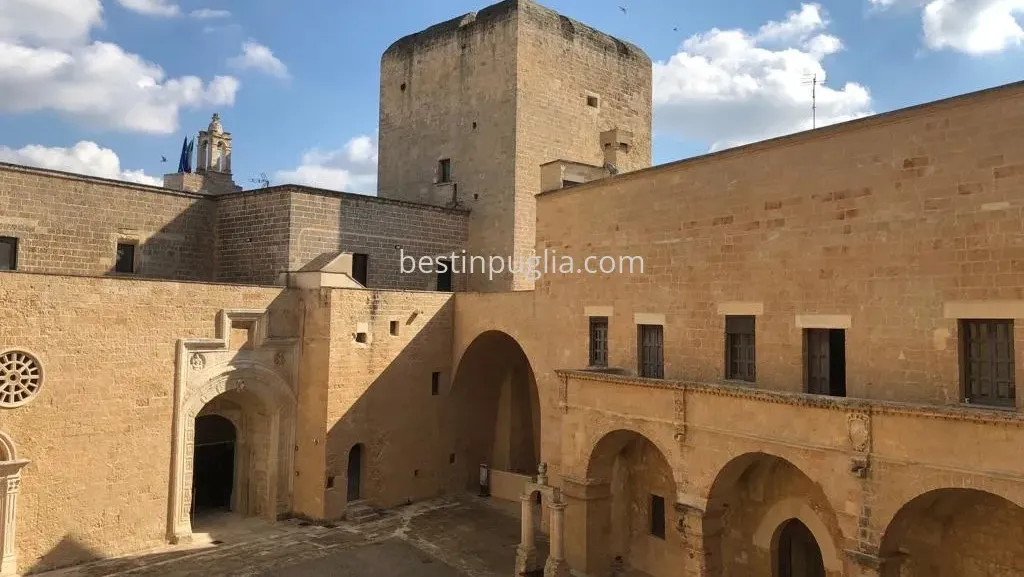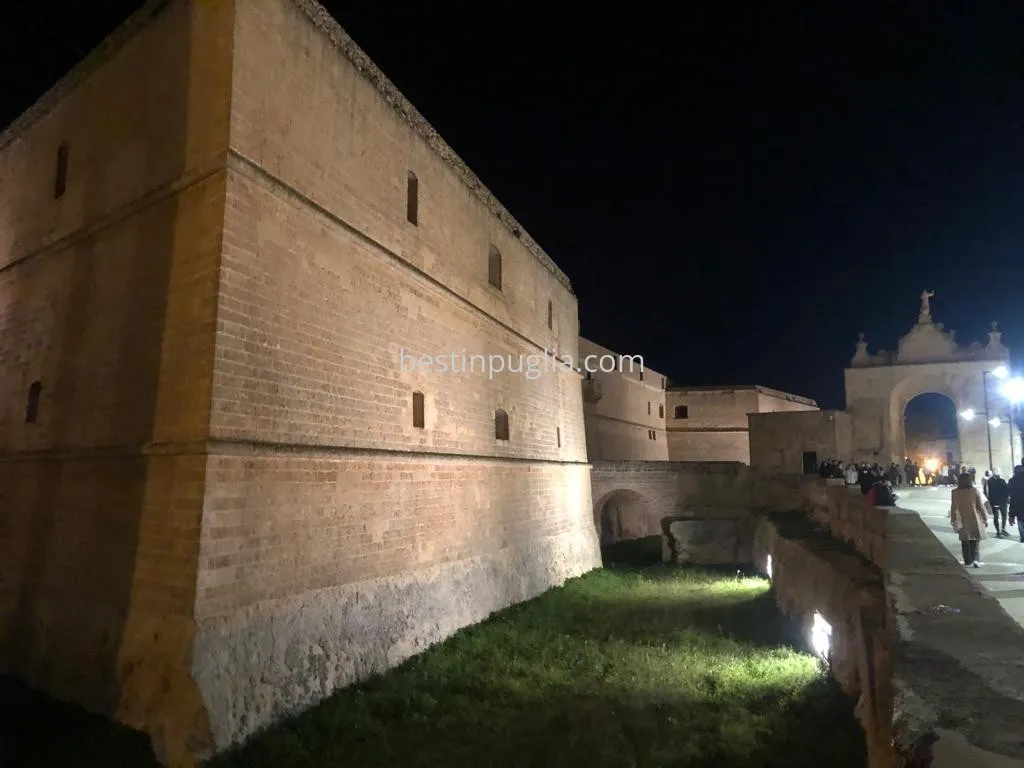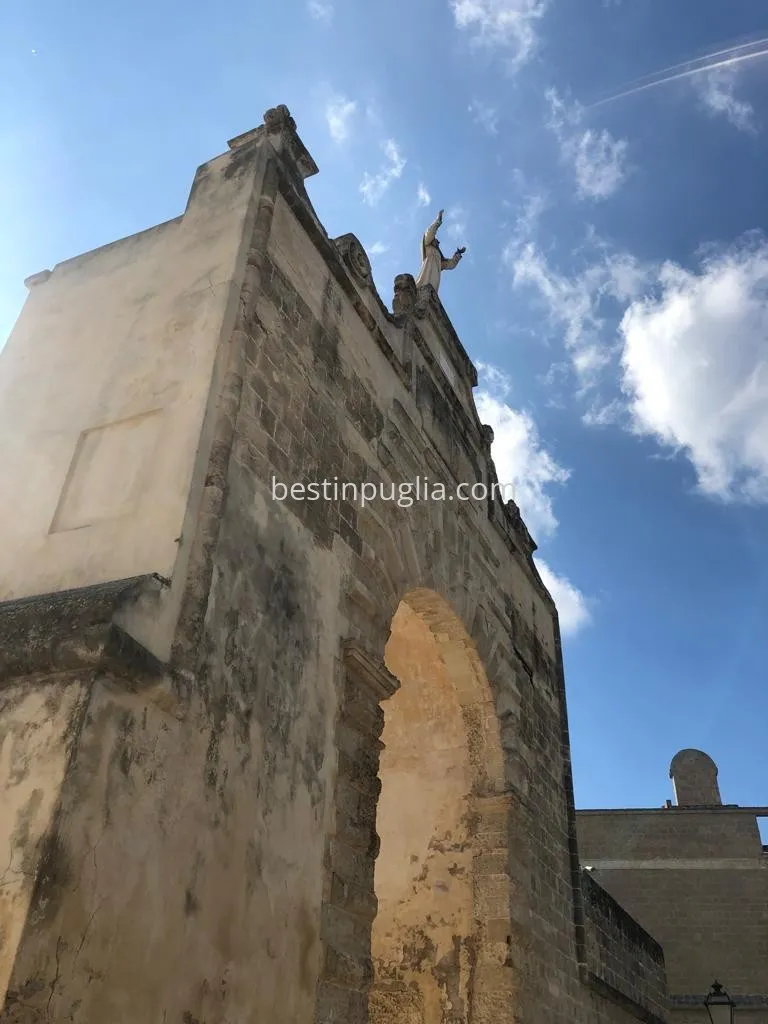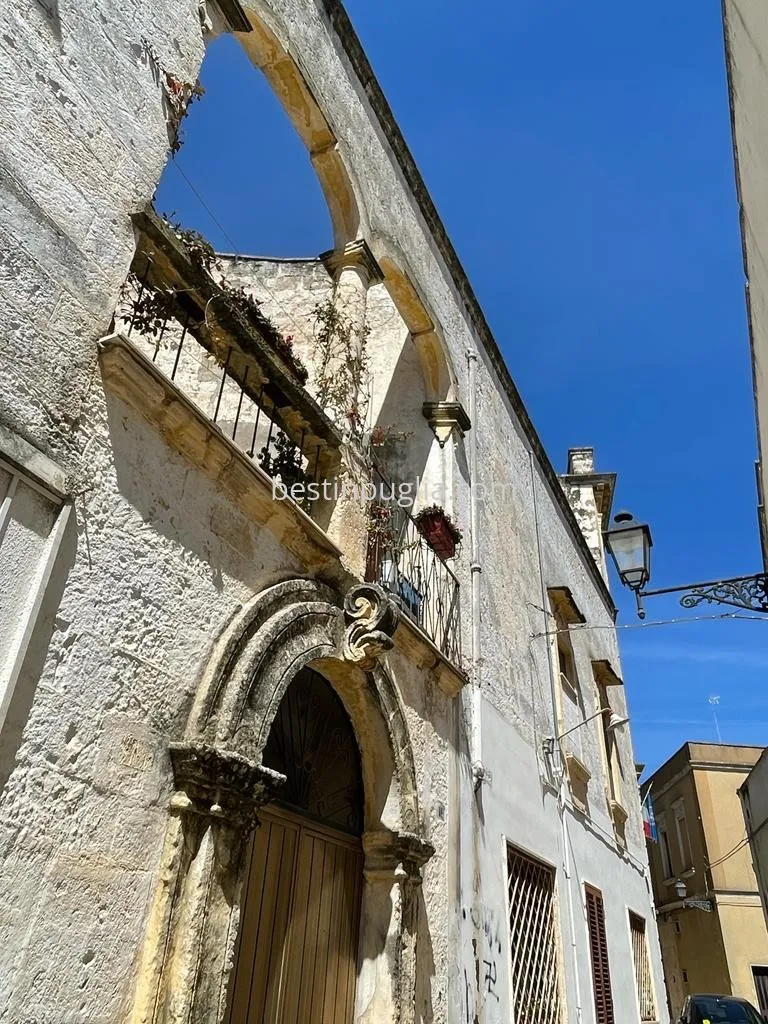Copertino: what to do and what to see in Cupertino in Puglia
Updated at: 01-12-2024
How this content can help you:
- The location of Copertino in Salento, near Lecce and Gallipoli.
- The history of the town and the origin of its name.
- The importance of Saint Joseph of Copertino, patron saint of aviators and students.
- Connection between Copertino and Cupertino in California.
- What to see: Basilica of Santa Maria ad Nives, Sanctuary of Saint Joseph, Copertino Castle, Monastery of Santa Chiara, Church of Santa Maria di Casole, City Gates, Squares.
- Traditional festivals and events in Copertino.

Copertino is a city located approximately 15 kilometers west of Lecce, in the heart of the Salento region, an area famous for its natural beauty, cultural heritage, and culinary traditions. It is also about 20 kilometers from the Ionian Sea, with the city of Gallipoli nearby.
Its location makes it easily accessible from both the Ionian coasts and the city of Lecce, thus serving as an important reference point in the area.
The city is best known as the birthplace of Saint Joseph of Copertino, the patron saint of aviators and students, and for its impressive Renaissance castle.
The name Copertino likely originates from the merging of several hamlets, and its original name, “Conventino,” might have given rise to the current one. This is symbolized in the city's coat of arms, which features a pine tree enclosed between the letters C and P, representing "Conventio Populorum," or the meeting of different peoples.
The city, which boasts many historical and artistic sites to visit, is also famous as the birthplace of Saint Joseph of Copertino, known as the “Saint of the Flights”: patron saint of aviators and the protector of those who travel by air, as well as of students, because he passed his exam to become a priest despite not being adequately prepared (legend has it he had infused knowledge).
The city of Cupertino in the heart of Silicon Valley was named after him because it was founded on March 23, 1776, the feast day of Saint Joseph. Since 1963, Cupertino has been twinned with Copertino, the birthplace of the saint.
Copertino clearly bears the numerous traces of the peoples who settled in Salento over the centuries.
What to do and see in Copertino in Puglia
Things to do and see in Copertino include:
- Basilica of Sancta Maria ad Nives
- Sanctuary of Saint Joseph
- Monastery of Santa Chiara
- Church of Santa Maria di Casole
- Castle of Copertino
- The City Gates
- The Squares
Basilica di Sancta Maria ad Nives
The Basilica of Santa Maria ad Nives, located in Copertino, Apulia, is an important historical and religious church. Also known as the Basilica of Our Lady of the Snows, it is a pilgrimage site dedicated to the Virgin Mary.
Construction began around 1572 and was completed a few years later, as part of a project aimed at creating a new place of worship dedicated to Our Lady of the Snows. The church was built on a site that already had a long history of Marian devotion, and over time, it became an important religious center in the region.
The basilica is closely associated with Saint Joseph of Copertino, a 17th-century Franciscan friar known for his deep devotion and mystical experiences, including levitations during moments of prayer. Saint Joseph is the patron saint of Copertino, and the basilica preserves several testimonies of his life and miracles.
The basilica is a destination for numerous pilgrimages, especially during the feast of Our Lady of the Snows, celebrated on August 5th, when the faithful gather to honor the Virgin with processions and religious celebrations.
Santuario di San Giuseppe
The Sanctuary of Saint Joseph of Copertino is one of the most significant places in Copertino, both for its spiritual value and its historical importance. Dedicated to Saint Joseph of Copertino, a Franciscan friar famous for his miracles and mystical ecstasies, the sanctuary is a highly visited pilgrimage site.
The construction of the sanctuary was completed in 1758, with the intent of honoring the figure of Saint Joseph, who is deeply venerated in the region. The building, with its Baroque architectural style, conveys a sense of solemnity and sacredness that befits the life of the saint.
A particularly precious element of this sanctuary is the presence of numerous relics of Saint Joseph, including his heart, which was transferred to Copertino from Osimo in 1953. This relic is one of the main reasons why so many faithful visit the sanctuary, seeking a spiritual connection with the saint.
Inside the sanctuary, there is also the small stable where Saint Joseph was born in 1603. This humble place, integrated into the building, offers visitors a direct link to the simple origins of the saint. The paternal house of Saint Joseph, located in the historic center of Copertino, is another point of interest for those who wish to delve deeper into the life of the saint.
Among the artworks preserved in the sanctuary, a prominent one is a late 19th-century painting that depicts a particularly touching episode: Saint Joseph miraculously appearing to his dying mother while he was in the convent of Assisi. This painting is just one of the many representations that celebrate the mystical life of the saint.
Monastery of Santa Chiara
The Monastery of Santa Chiara is a place of great historical and spiritual importance, closely linked to the tradition of the Poor Clares, the monastic order founded by Saint Clare of Assisi. Built in the 17th century, the monastery reflects the intense devotion to Saint Clare and the Franciscan ideals that characterized the era.
The complex has a simple and functional architecture, typical of monastic buildings, but it also features decorative details that enrich its appearance. For centuries, the monastery was a center of contemplative life, where cloistered nuns lived according to a strict rule of prayer, work, and silence, in full conformity with the teachings of Saint Clare, which exalted poverty and community life.
The spiritual heart of the monastery is the adjoining church, simple but welcoming, dedicated to Saint Clare and Saint Francis of Assisi. Inside, there are altars and sacred artworks that reflect the community's devotion and the influence of Franciscanism in the region.
Although the presence of nuns has diminished over the years, the Monastery of Santa Chiara remains a place of deep devotion. It is frequented by the faithful and visitors who seek a moment of reflection and prayer, immersed in an atmosphere of peace and spirituality.
This monastery is a true symbol of the religious and cultural heritage of Copertino, where the Franciscan tradition remains alive and vibrant, offering everyone who visits an opportunity to reflect and connect with a history of faith that spans centuries.
Church of Santa Maria di Casole
The Church of Santa Maria di Casole, located in the countryside of Copertino, is a place rich in history and charm. This church, one of the oldest in the region, offers a unique glimpse into the Christian presence in Apulia over the centuries.
Built in the 12th century, the church has even older roots, probably dating back to the Byzantine era. Its architecture is simple yet evocative, with a stone façade and a small bell tower, typical of rural churches of that period. The building is a perfect example of how Romanesque and Byzantine influences intertwined over the centuries.
Inside the church, the most striking feature is the frescoes that adorn the walls. These paintings, created between the 12th and 14th centuries, depict biblical scenes, figures of saints, and the Virgin Mary. Their style is a fascinating blend of Byzantine art and local Romanesque influences, offering a precious example of medieval sacred art.
The Church of Santa Maria di Casole played a fundamental role in the religious life of the community for many centuries. During the Middle Ages, it was a point of reference not only for the local inhabitants but also for pilgrims passing through the region.
Today, the church is considered a true treasure of Copertino's cultural heritage. Although it is no longer at the center of daily religious life, it continues to attract visitors interested in discovering the history and sacred art of the area.
This place, with its ancient and solemn atmosphere, represents a tangible link to the past, keeping alive the memory of the Christian faith that deeply marked the history of Apulia.
The Castle of Copertino

The Castle of Copertino is undoubtedly one of the most fascinating and significant monuments in the city. Built in the 16th century, this imposing building tells centuries of history, from its medieval origins to its transformation into a Renaissance fortress.
The roots of the castle date back to the 13th century when the first fortification was erected to defend the territory. However, the structure we see today is the result of a major renovation commissioned by the Castriota family in the 16th century.
They transformed the castle into a modern fortress, with robust walls, angular bastions shaped like spear points, and a large moat that strengthened its defenses. A fascinating detail is the drawbridge, which in the past could be raised to completely isolate the castle.
Inside, the castle is arranged around a large central courtyard, surrounded by elegant loggias. This interior space reflects not only the military function of the structure but also its use as a noble residence. The rooms, some of which are decorated with frescoes and coffered ceilings, reveal the refined taste of the Renaissance era and the owners' intention to make it a place of prestige.
Another element of great interest is the Chapel of San Marco, located inside the castle. Decorated with 16th-century frescoes and featuring a finely carved stone altar, the chapel demonstrates the importance of the religious dimension even in a predominantly military context.
Today, the Castle of Copertino is an important cultural and historical landmark of the city. The castle hosts cultural events, exhibitions, and guided tours, offering visitors the opportunity to explore its fascinating history up close.
This castle, with its grandeur and eventful history, is a symbol of the city of Copertino and represents the resilience and strength of the local community over the centuries.
The City Gates
Among the civil architectures of Copertino, the City Gates deserve mention as they once marked the entrance to the historic center of the city. The most famous is the Gate of San Giuseppe, dedicated to the city's patron saint.
These gates, originally part of the defensive walls, are now historical symbols that recall the ancient urban layout.
The Squares
The squares of Copertino, such as Piazza del Popolo and Piazza Umberto I, represent the heart of the city's life. These public spaces, surrounded by historic buildings and churches, are places of meeting and socialization, as well as witnesses to the city's civil history.
The squares are often animated by markets, events, and cultural manifestations, helping to keep alive the community tradition of Copertino.
Festivals and Events in Copertino
Not to be missed in Copertino is the patronal feast dedicated to its patron saint—Saint Joseph Desa, protector of aviators and students—with four days of celebration from September 16 to 19, filling the historic center of the city with sacred rites, illuminations, live music, and cultural events in which the Saint of Flights is the absolute protagonist. The festivities also feature stalls and moments dedicated to the Salento's culinary traditions.
In early August, the old town of Copertino comes alive in celebration of August 5, the day commemorating the miracle of Our Lady of the Snows, to whom the city's main church is dedicated. During this period, the town hosts the evocative historical parade in costume, known as the "Madonna della Neve."
Each edition of the event goes beyond religious ceremonies to include medieval games tournaments among the five ancient casali of Copertino. The historical parade, which starts from the Castle, winds through the streets of the city and is enlivened by flag-wavers, archers, musicians, jugglers, street performers, and over 150 costumed figures, creating a festive atmosphere that evokes the traditions of the past.
During San Lorenzo's Days, at the beginning of the second week of August, the city becomes the stage for the most important wine event: "Calici di Stelle", organized by the Wine Tourism Movement of Puglia in synergy with the municipalities of Arnesano and Porto Cesareo: tastings, masterclasses, and wine-related activities, which have always been one of the most important aspects of Apulia's economy (and taste).
At the end of August, the city hosts the Festival of the Stornello, dedicated to folk singing and its timeless beauty: each year, the most famous artists—but especially the most renowned female artists—of this tradition, which has deep historical roots in southern Italy, are invited.
Finally, in November, just after the harvest, "Le vie del vino" (The Wine Routes) is the food and wine festival that enlivens the streets of the historic center: the local restaurants prepare traditional Salento dishes, and the wineries of the area are ready to offer tastings of their labels to visitors coming from all over Salento, and beyond.
Photo of Copertino





